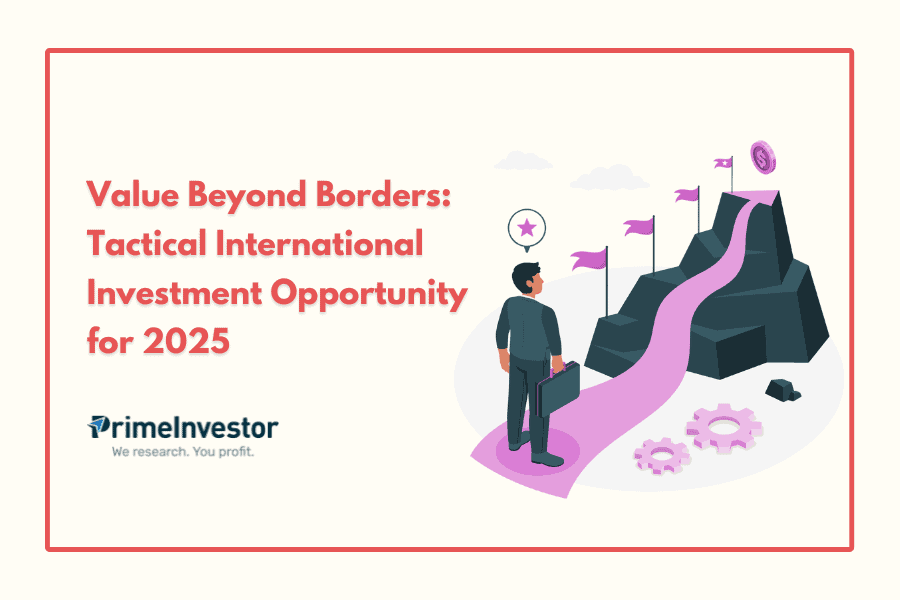As Indian markets declined, we’ve consistently recommended stocks to strategically average as well as new ones to add to your portfolio. Simultaneously, we’ve looked beyond domestic opportunities to identify global options as well. While our international exposure typically centres on the US market, current conditions have prompted us to suggest a three-pronged strategy to make the best of the current market condition.

- Tactical Opportunity: Despite bearing the brunt of the US trade tariffs, this giant economy is developing coping mechanisms that present a timely investment opportunity. This tactical position requires vigilant monitoring and an active profit-booking strategy.
- Domestic Strength During Correction: The correction only enhances the case for investing in stocks given India’s fundamentally sound economy. Indian funds should remain the cornerstone of your portfolio allocation.
- Strategic Diversification: A long-term position in a major economy currently facing uncertainties but with strong recovery potential. This can serve as a long-term portfolio diversifier with promising future returns.
In other words, the second opportunity mentioned above should remain a substantial portion of one’s portfolio allocation, the third one as a diversifier and the first one as a tactical call that would need an active profit booking strategy.
We will be giving these calls at different points over the next few weeks or months, beginning this week. To maximize these opportunities, ensure your PrimeInvestor subscription remains active (😊) and regularly check your email or our blog for detailed analysis and timely recommendations. We are starting with the tactical opportunity in this report.
Tactical opportunity – Enter the Dragon
We recommend a targeted allocation to the Nippon India ETF Hang Seng BeES for high-risk investors seeking tactical exposures. Unlike most global markets that have recovered strongly since the pandemic, China’s stock market lagged behind until recently.
The underperformance was for clear reasons. The Chinese economy was facing mounting pressure from a slowing property market, weak consumer demand, global economic uncertainties and lately, a trade war with the US.
China’s 2024 stimulus package tried to address some of these concerns and the Chinese market saw a return of foreign investors. But we refrained from recommending it then considering the uncertainties surrounding the US elections and trade policies under Trump. There is now some clarity on what trade policies will look like under Trump.
But Chinese stock markets managed to climb the wall of worry and surge ahead. China has emerged as a notable outperformer with the Hang Seng index rising 57% since January 19, 2024 (the Shanghai Stock Exchange Composite index rose much later from September 2024 after the announcement of stimulus).
Despite this impressive rally, the Hang Seng continues to trade at a substantial discount compared to other global indices. The Hang Seng is at a trailing (as of March 12, 2025) PE of 13.6 times versus the US S&P 500’s 28.7 times, the Nifty 50’s 20 times and the MSCI Emerging Market’s (ex-China) 15.3 times.
This valuation gap presents a compelling entry opportunity for investors willing to accept the higher volatility and risk that comes with the Chinese market. While political concerns justify some discount, current market conditions present a tactical opening if one considers China’s enduring strengths: its undeniable manufacturing and trade dominance, trade surplus, export diversification and demonstrated resilience against tariffs based on its effective handling of similar measures in 2018. These factors buttress our investment case now.
Undeniable dominance
China represents about 30% of worldwide manufacturing output, maintaining its status as the global manufacturing leader for over a decade and a half now. And it is keen to establish its dominance in emerging sectors as well. The Economic Survey 2024-25 from the Indian Government clearly lists details on the dominance of China in all major emerging sectors. Here’s what we picked from the report and from other sources.
China’s manufacturing dominance has transformed the global automotive industry (especially EVs), critical mineral supply chains, and clean energy equipment production. China’s rise has disrupted traditional leaders like Germany and Japan while establishing Chinese control over vital resources, creating potential dependencies for other nations. Let us look at some of the many areas it dominates.
#1 Critical Minerals & Resources
China dominates the global distribution of critical minerals and other economic resources.
#2 Renewable Energy Sector
- Solar photo voltaic (PV) manufacturing: China has invested more than USD 50 billion in new PV supply capacity (ten times more than Europe). It’s share of solar panels (polysilicon, ingots, wafers, cells, and modules) exceeds 80% across all manufacturing stages. This is more than double China’s share of global PV demand. China is home to the world’s top 10 suppliers of solar PV manufacturing equipment.
- Wind energy: About 60% of the world’s wind installed capacity is sourced from China.
- Battery technology: China houses nearly 80% of the world’s battery manufacturing capacity
In 2022, China allocated USD 546 billion toward investments in solar and wind energy, electric vehicles, and battery technologies. For comparison, US and EU investments in these sectors amounted to USD 321 billion in the same year.
#3 Electric Vehicle Supply Chain
- China has achieved vertical integration across the entire EV supply chain, from mining to manufacturing.
- This integration has enabled China to maintain global dominance in the EV sector.
- Lithium-ion batteries are expected to remain dominant with demand projected to grow at a CAGR of 23% by 2030
What makes this dominance particularly remarkable is that all this has been achieved despite the economic challenges China has faced since 2016.
The market disconnect
Connect the above with its stock market movements in the recent decade.
Following its post-financial crisis recovery, the Hang Seng Index reached new heights before facing sequential setbacks: first the China growth scare in 2016, then the 2018 US trade war, and finally a devastating COVID-19 impact. The index’s profound underperformance from February 2021 to January 2024—reaching decadal lows in 2022—represents an extraordinary market disconnect. Despite China’s expanding economic dominance across manufacturing, EVs, renewable energy, and critical minerals as detailed above, negative sentiment driven by geopolitical tensions created a sustained valuation gap. This stark divergence between depressed market prices and underlying economic strength presents today’s compelling tactical opportunity.
The other disconnect is the divergence in Hang Seng Index’s earnings and GDP Growth. If one looks at the Earnings growth for the last 5 years (derived from Hang Seng index value and the PE), there is a decline of per share earnings by 3.4% annually. China’s DGP though has grown by 5% CAGR over the 5 years ending 2024. If one looks at the constituents of the Hang Seng, the sectors with the highest weight financials and consumer discretionary delivered weak returns in the index.
We think the current discounted valuations have factored this earnings weakness already. Now with China’s technology shining bright and the government doling out subsidiaries to lift consumer spending, we can expect some uptick in the index’s growth from these sectors.
Also, on the positive side, the index’s dividend yield of 3.3%, provides sufficient cushion, even with weak earnings, at these entry levels.
China’s resilience in the face of challenges
China has not remained passive during these challenges. Instead, it has taken deliberate, systematic steps to build resilience against global opposition.
Export diversification: China has systematically reduced its exposure to US trade actions since the 2018 tariff confrontation. By 2024, ASEAN became China’s primary export destination at 16.4%, followed by the US (14.7%) and EU (14.4%) according to Statista.com. This represents a significant shift from 2018, when the US accounted for 19.2% of Chinese exports.
The strategic adjustment is further evidenced by China’s declining US export dependency as a percentage of GDP—falling from 3.5% to 2.9% between 2018 and 2023. While the new tariffs will still impact China’s economy, the country’s deliberate market diversification has progressively reduced its vulnerability to US trade measures.
Trade surplus: China has systematically increased its exports leading to a surge in its trade surplus (exports higher than imports) from $421.9 billion in 2019 to $992.16 billion in 2024 – a 135% increase. A trade surplus not only provide precious foreign exchange reserve but act as cushion in periods of economic shocks. They also help a nation spend big time on economic boosters such as large infrastructure projects.
Other measures: China had multiple other ways to deal with the tariffs imposed in 2018. These include:
- Allowing the yuan to systematically depreciate against the US dollar thus reportedly offsetting 30-40% of tariff costs for Chinese exporters
- Assembly relocation by way of moving tariff-hit production to alternative locations such as Vietnam, Malaysia, Thailand and even Mexico.
- Increasing the Chinese content in the output of other Asian countries that exported to US.
While some of these measures may no longer be possible this time round (tariffs on Mexico as well), China has demonstrated great resilience in earlier trader wars. This time, it is also hitting back with 10-15% tariffs on US agricultural goods (corn, beef, pork, dairy, soybeans).
The real challenge is internal
China’s external pressures are actually less concerning than its internal challenges to growth. China faces pressure in achieving its ambitious 5% GDP growth target amid property market decline and weak consumer spending. To add to this, China is now facing deflation. However, deflation can pave the way for China to double down on a monetary stimulus. With a managed currency, China’s central bank has more leeway to pursue an independent monetary policy than economies like India.
China is already focusing on stimulating consumer spending. It doubled consumer trade-in subsidies to 300 billion yuan ($41.47 billion) for 2024. Subsidies will cover 15-20% of purchase prices for select mid-range consumer products including smartphones and home appliances. This is an expansion from the narrower 150-billion-yuan programme introduced in 2023. Despite concerns that the impact of these one-time subsidies would be temporary, additional programmes are expected to follow. The country hopes this consumption-driven approach aligns with its 5% GDP growth target rather than traditional infrastructure spending.
Besides, this, a quiet transformation is happening in the Chinese stock market as well. China’s government now recognizes it needs private innovation, but this lesson came the hard way. DeepSeek delivered the wake-up call—becoming both a milestone for Chinese AI and a market catalyst that instantly boosted stocks and changed investor sentiment.
After a crack-down on tech companies a few years ago, there now seems to be realisation that private companies are essential, especially as China competes with the US in technology. The government can no longer rely solely on state-driven innovation.
Even with these, a 5% growth for such a large economy isn’t going to be easy to achieve. But the country’s resilience thus far and the attractive valuations make for a good entry point at this stage to pocket some gains. It is for this reason that FIIs have been shifting their allocation to China.
About the Hang Seng index
The Hang Seng index is the primary benchmark for the Hong Kong stock market with 82-83 stocks. It comprises the largest and most liquid stocks on the Hong Kong Stock Exchange Main Board. Stocks are freefloat-adjusted with 8% cap on individual stocks. Financials, technology and consumer discretionary are the top sector weights and Alibaba, HSBC Holdings, Tencent Holdings Meituan Dianpeng (Consumer discretionary) and Xiaomi are among the top holdings. The table below will show that the Hang Seng hasn’t delivered over a 5-year period and is a recent outperformer.
Suitability
This is the only ETF from India to play the Hang Seng. The ETF trades at a marginal premium to NAV. So, you can buy it only at a premium now. Lumpsum exposure is recommended only if you are willing to take on country risks which are:
- US-China relations remain challenging
- Technology restrictions can impact growth potential in key sectors.
- Real estate market stress and household debt continues to weigh on consumer confidence and debt issues in the sector remain unresolved.
- With a non-democratic leader, whimsical policy shifts can create volatility.
- China is also a strange mix of a market and communist economy, with policymaking tending to extremes. During times of market correction, the Chinese government has been know to step in and curb FII selling etc. This may lead to FIIs proceeding cautiously on China.
- Foreign investor concerns about corporate governance persist.
To manage these risks, if you decide to invest, your exposure to this ETF should not account for more than 5% of your total equity portfolio. We will issue calls on exit or book profit and you need to actively also rebalance if the situation warrants. Short-term volatility in the index can continue.




40 thoughts on “Value Beyond Borders: Tactical International Investment Opportunity for 2025”
Hi,
While this is tactical opportunity, what is the investment horizon that we can expect given that as an investor I’ll be going with the PI’s call on BUY, Book profit and/or Sell.
This is more tactical from an entry perspective. As an income generator, it is expected to be long term and we will move it to hold if price becomes too high for new investors (not for existing holders) and to a sell if asset growth reduces or dividend ditribution does not grow at all. Vidya
Any update on this after Trump tariff move?
No Sir. the Call remains. We haven’t given any call on US as yet. Vidya
Hi Vidya, are international ETFs from Nippon and other Indian MFs still open for fresh subscription? Are ETFs, too, not subject to the $7 billion industry-wide ceiling that was hit a few years ago. I have conflicting reports on this from various AMCs, some of whom no longer offer these products on their website.
REgards — Ravil
ETFs don;t create units all the time. So there is no fresh inflow. They are traded in the stock exchange like stocks, with the existing supply. That is why there is a deviation of their market price from the NAV – depending on whether supply is more or less. When demand is high the market price deviates from the NAV more. That is what is happening now due to the restriction. Thanks.
Hello Ma’am
How are these International ETFs taxed.
Thanks.
Gold and international ETFs will be treated as listed securities for tax purposes. Short-term holding cutoff is 12 months and gains will be taxed at 20%. Long-term gains will be taxed at 12.5% without indexation.